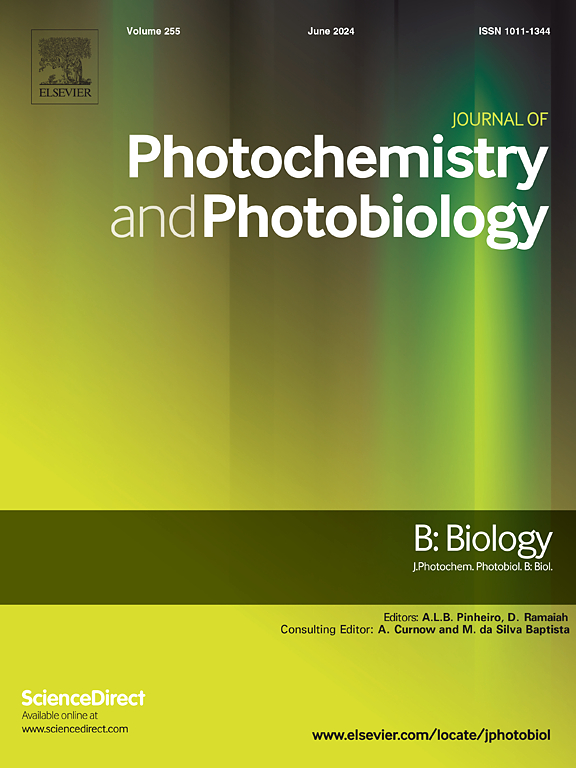Suppression of NRF2 by photodynamic action to enhance bortezomib-triggered DNA damage for synergistic colorectal cancer therapy
IF 3.7
2区 生物学
Q2 BIOCHEMISTRY & MOLECULAR BIOLOGY
Journal of photochemistry and photobiology. B, Biology
Pub Date : 2025-04-03
DOI:10.1016/j.jphotobiol.2025.113162
引用次数: 0
Abstract
Anti-tumor agent bortezomib (BTZ) showed poor efficacy in colorectal cancer (CRC), which is attributed to the high expression of KEAP1-NRF2, an essential anti-oxidative system. Oxidative DNA damage is one of the critical mechanisms by which photodynamic therapy (PDT) induces apoptosis in tumor cells, which can be considered an important tool for early non-invasive treatment of CRC. The present work aims to explore the role and mechanism of PDT synergizing with BTZ in the treatment of CRC. The findings showed slight decrease in cell viability in BTZ-treated CRC cells of SW480 and SW620. KEAP1-NRF2 was highly expressed in CRC as revealed by GEPIA, TIMER databases, and in vitro experiments, conferring antioxidant activity. Further investigation revealed BTZ bound KEAP1, resulting in KEAP1-NRF2 decoupling, which was manifested as downregulation of KEAP1 and upregulation of NRF2. CO-IP test provides in-depth confirmation that BTZ impaired NRF2 ubiquitination. When SW480 and SW620 cells were co-treated with the chlorin e6 (Ce6)-PDT and BTZ, the expression of NRF2 was reduced with increased ROS generation and enhanced DNA damage. The combination of PDT and BTZ exhibited robust anti-CRC efficacy, characterized by increased apoptosis in SW480 and SW620 cells and dramatic inhibition of tumor growth in SW480 cell-bearing mice. To summarize, Ce6-mediated PDT combined with BTZ suppresses NRF2 and thus enhances DNA damage against CRC. The present study uncovered the molecular mechanism of redox in CRC and recommends an effective intervention strategy with PDT.

通过光动力作用抑制NRF2,增强硼替佐米引发的DNA损伤,协同治疗结直肠癌
抗肿瘤药物硼替佐米(bortezomib, BTZ)在结直肠癌(colorectal cancer, CRC)中的疗效较差,这与必需的抗氧化系统KEAP1-NRF2的高表达有关。DNA氧化损伤是光动力疗法诱导肿瘤细胞凋亡的重要机制之一,是早期无创治疗结直肠癌的重要手段。本研究旨在探讨PDT与BTZ协同治疗结直肠癌的作用及机制。结果显示,btz处理的SW480和SW620结直肠癌细胞的细胞活力略有下降。GEPIA、TIMER数据库和体外实验显示,KEAP1-NRF2在CRC中高表达,具有抗氧化活性。进一步研究发现BTZ结合KEAP1,导致KEAP1-NRF2解耦,表现为KEAP1下调,NRF2上调。CO-IP试验深入证实BTZ损害NRF2泛素化。当氯e6 (Ce6)-PDT和BTZ共处理SW480和SW620细胞时,NRF2的表达降低,ROS生成增加,DNA损伤增强。PDT和BTZ联合使用显示出强大的抗crc疗效,其特征是增加SW480和SW620细胞的凋亡,并显著抑制SW480细胞携带小鼠的肿瘤生长。综上所述,ce6介导的PDT联合BTZ抑制NRF2,从而增强CRC的DNA损伤。本研究揭示了CRC中氧化还原的分子机制,并推荐了一种有效的PDT干预策略。
本文章由计算机程序翻译,如有差异,请以英文原文为准。
求助全文
约1分钟内获得全文
求助全文
来源期刊
CiteScore
12.10
自引率
1.90%
发文量
161
审稿时长
37 days
期刊介绍:
The Journal of Photochemistry and Photobiology B: Biology provides a forum for the publication of papers relating to the various aspects of photobiology, as well as a means for communication in this multidisciplinary field.
The scope includes:
- Bioluminescence
- Chronobiology
- DNA repair
- Environmental photobiology
- Nanotechnology in photobiology
- Photocarcinogenesis
- Photochemistry of biomolecules
- Photodynamic therapy
- Photomedicine
- Photomorphogenesis
- Photomovement
- Photoreception
- Photosensitization
- Photosynthesis
- Phototechnology
- Spectroscopy of biological systems
- UV and visible radiation effects and vision.

 求助内容:
求助内容: 应助结果提醒方式:
应助结果提醒方式:


